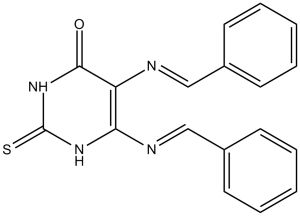SCR7 (SCR-7; SCR 7) is a potent and selective inhibitor of DNA Ligase IV with potential anticancer activity. The enzyme DNA Ligase IV is in charge of using the non-homologous end joining (NHEJ) repair pathway to fix DNA double-strand breaks (DSB).
Physicochemical Properties
| Molecular Formula | C18H12N4OS | |
| Molecular Weight | 332.38 | |
| Exact Mass | 334.088 | |
| Elemental Analysis | C, 64.65; H, 4.22; N, 16.75; O, 4.78; S, 9.59 | |
| CAS # | 1533426-72-0 | |
| Related CAS # | 14892-97-8 | |
| PubChem CID | 91885409 | |
| Appearance | Yellow solid powder | |
| Density | 1.3±0.1 g/cm3 | |
| Boiling Point | 644.9±65.0 °C at 760 mmHg | |
| Flash Point | 343.8±34.3 °C | |
| Vapour Pressure | 0.0±2.0 mmHg at 25°C | |
| Index of Refraction | 1.675 | |
| LogP | -0.22 | |
| Hydrogen Bond Donor Count | 2 | |
| Hydrogen Bond Acceptor Count | 4 | |
| Rotatable Bond Count | 4 | |
| Heavy Atom Count | 24 | |
| Complexity | 570 | |
| Defined Atom Stereocenter Count | 0 | |
| InChi Key | NEEVCWPRIZJJRJ-LWRDCAMISA-N | |
| InChi Code | InChI=1S/C18H14N4OS/c23-17-15(19-11-13-7-3-1-4-8-13)16(21-18(24)22-17)20-12-14-9-5-2-6-10-14/h1-12H,(H2,21,22,23,24)/b19-11?,20-12+ | |
| Chemical Name | 5-(benzylideneamino)-6-[(E)-benzylideneamino]-2-sulfanylidene-1H-pyrimidin-4-one | |
| Synonyms |
|
|
| HS Tariff Code | 2934.99.9001 | |
| Storage |
Powder-20°C 3 years 4°C 2 years In solvent -80°C 6 months -20°C 1 month |
|
| Shipping Condition | Room temperature (This product is stable at ambient temperature for a few days during ordinary shipping and time spent in Customs) |
Biological Activity
| Targets | DNA Ligase IV; CRISPR/Cas9 | ||
| ln Vitro |
|
||
| ln Vivo |
|
||
| Enzyme Assay | The oligomeric DNA substrates (5' compatible and 5' noncompatible ends) and increasing concentrations of purified Ligase IV/XRCC4 complex (30, 60, and 120 fmol) are added to the SCR7-treated extracts to conduct the complementation experiment. At 25°C, reactions are incubated for two hours. Following that, the reaction products are separated on an 8% denaturing PAGE. A PhosphorImager is used to detect the signal after the gel has dried and been exposed, and Multi Gauge (V3.0) software is used for analysis. | ||
| Cell Assay | MTT and trypan blue assays are used to measure the proliferation of cancer cells. In summary, SCR7 (10, 50, 100, and 250 μM) is added to MCF7, CEM, HeLa, A549, HT1080, A2780, T47D, Nalm6, N114, and K562 cells during 24 or 48 hours of growth before the cells are tested using MTT or trypan blue. Every experiment is conducted at least three separate times. | ||
| Animal Protocol |
|
||
| References |
[1]. Cell . 2012 Dec 21;151(7):1474-87. [2]. Nat Biotechnol . 2015 May;33(5):543-8. [3]. Scientific Reports. 2017, 7, Article number: 8943. |
Solubility Data
| Solubility (In Vitro) |
|
|||
| Solubility (In Vivo) |
Solubility in Formulation 1: ≥ 2.5 mg/mL (7.48 mM) (saturation unknown) in 10% DMSO + 40% PEG300 + 5% Tween80 + 45% Saline (add these co-solvents sequentially from left to right, and one by one), clear solution. For example, if 1 mL of working solution is to be prepared, you can add 100 μL of 25.0 mg/mL clear DMSO stock solution to 400 μL PEG300 and mix evenly; then add 50 μL Tween-80 to the above solution and mix evenly; then add 450 μL normal saline to adjust the volume to 1 mL. Preparation of saline: Dissolve 0.9 g of sodium chloride in 100 mL ddH₂ O to obtain a clear solution. Solubility in Formulation 2: ≥ 2.5 mg/mL (7.48 mM) in 10% DMSO + 40% PEG300 + 5% Tween80 + + 45% Saline For example, if 1 mL of working solution is to be prepared, you can take 100 μL of 25 mg/mL of DMSO stock solution and add tO + 400 μL of PEG300, mix well (clear solution); Then add 50 μL of Tween 80 to the above solution, mix well (clear solution); Finally, add 450 μL of saline to the above solution, mix well (clear solution). Preparation of saline: Dissolve 0.9 g of sodium chloride in ddH ₂ O and make up to 100 mL to obtain a clear and transparent saline solution. (Please use freshly prepared in vivo formulations for optimal results.) |
| Preparing Stock Solutions | 1 mg | 5 mg | 10 mg | |
| 1 mM | 3.0086 mL | 15.0430 mL | 30.0860 mL | |
| 5 mM | 0.6017 mL | 3.0086 mL | 6.0172 mL | |
| 10 mM | 0.3009 mL | 1.5043 mL | 3.0086 mL |
